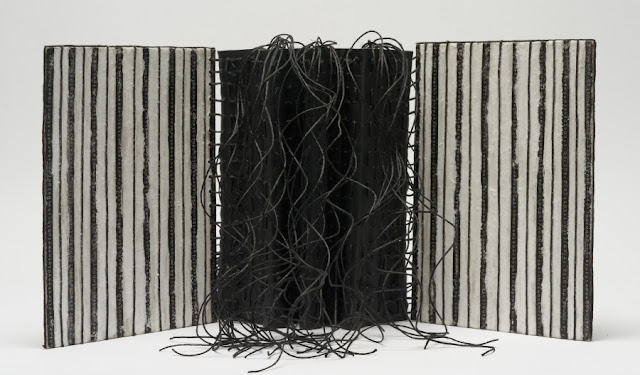 |
| “It's Not Black and White”, (interior/open), Book board, mulberry paper, used typewriter ribbon, canvas, hemp cord, 2021 |
Part 42 of an interview series in which artists reply to the same six questions. Debra Disman makes sculptural objects from a combination of materials that can be read as fiber art, yet also imply book forms. Her work is a mesmerising combination of materials, textures, and forms that are combined with exceptional skill. You can see more of her work here. Other interviews on this blog are available here.
Philip Hartigan: What medium/media do you chiefly use, and why?
Debra Disman: At the present time, I am working primarily in what you might call fiber: cloth/fabric/textiles/, including canvas, jute, lace and ribbon; and thread/string/cord, along with book board, paper, such as watercolor and mulberry papers; acrylic paint and adhesives. I interweave other materials such as used typewriter ribbon, varnish and plaster gauze into the works---whatever is needed to bring the emotional message home materially. I really have a passion for cloth, and string too, and putting them together. Cloth is truly as close to human as I think a non-sentient material can be with incredible expressive potential, it is what we are wrapped in often, at our inception and end, it can conform to the human or other bodies, yet has a life of its own. I also love the seeming independence of string, thread and cord, the way they fall and become entangled and entwined, without our intervention, just like human beings and other forms of life!
DD: I am working to complete a series of works that comprise my Santa Monica Artist Fellowship project: an investigation and response to the work of and concurrencies between the groundbreaking oeuvre of the artists Charlotte Salomon and Eva Hesse, which I will be showing in June. I have committed to a series of five works, in addition to research and learning new ways to present my work.
| “Excavation of the Interior”, (interior detail), Wood, mulberry paper, canvas, muslin, linen thread, hemp cord, 2021 |
DD: One surprise, which is also a challenge, is how long it is taking to translate my ideas into visual form, and how much concentration it is taking. Luckily, this has been a year-long endeavor. I am stitching text into several of the works, and it is always fascinating to see, as one sews, when exactly the stitching transforms into something beyond the purely the visual, at the moment when all those little lines connect and become readable words that can communicate on another level.
PH: What other artistic medium (or non-artistic activity) feeds your creative process?
DD: I am passionate about dance/movement/bodywork; literature/writing/reading; and I love emotive, thought-provoking, intelligent works on the large and small screen. I guess you could say I love story. I live with an actor, so we spend time engaging with this! I also very much need what I call stillpoint: quiet time just to be, get focused, and both rest and awaken the mind. Harder and harder to claim, as the world becomes ever more digital and connected, and it is harder and harder to “get away” and not feel like you just can’t stop.
| “Forest Through The Trees”, (exterior/interior), Book board, used typewriter ribbon, ribbon, acrylic paint, wood, hemp cord, canvas, 2021 |
DD: I drew all the time as a child on shirt, cardboard, or whatever. I don’t remember when it started! I also remember making things out of grasses and things I found lying around.

